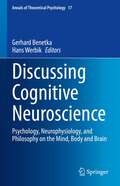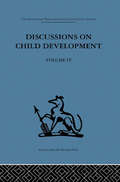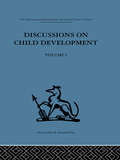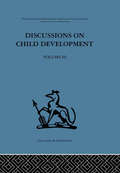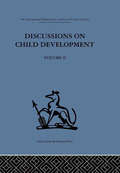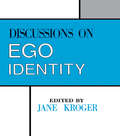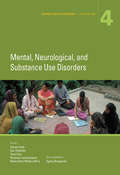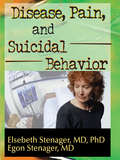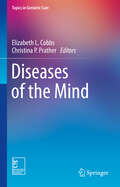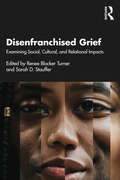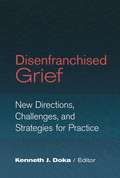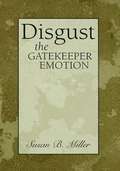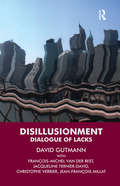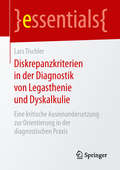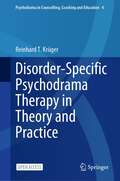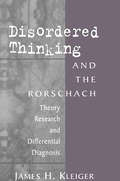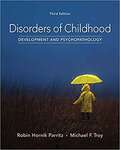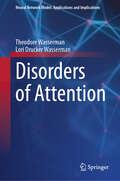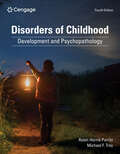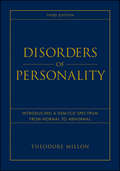- Table View
- List View
Discussing Cognitive Neuroscience: Psychology, Neurophysiology, and Philosophy on the Mind, Body and Brain (Annals of Theoretical Psychology #17)
by Gerhard Benetka Hans WerbikThe sciences philosophy, psychology and neuroscience share the basis that all refer to the human being. Therefore, an interdisciplinary collaboration would be desirable. The exchange of criticism is an essential requirement for interdisciplinary collaboration. Criticism must be heard and – if possible – considered. Indeed, criticism can be valid or unwarranted. However, whether criticism is unwarranted can only emerge from discussion and conversation. In the discussion of cognitive neuroscience, some criticism can easily be considered (such as the mereological fallacy that represents that talking about the person is substituted with talking bout the brain). Another issue for an interdisciplinary discussion of cognitive neuroscience is the interpretation of the readiness potential including re-considering Benjamin Libet’s classic experiments. Additionally, a critical discussion on cognitive neuroscience must address ethical questions, such as the possibility of the abuse of neuroscientific insight.
Discussions on Child Development: Volume four
by Bärbel Inhelder J. M. TannerTavistock Press was established as a co-operative venture between the Tavistock Institute and Routledge & Kegan Paul (RKP) in the 1950s to produce a series of major contributions across the social sciences. This volume is part of a 2001 reissue of a selection of those important works which have since gone out of print, or are difficult to locate. Published by Routledge, 112 volumes in total are being brought together under the name The International Behavioural and Social Sciences Library: Classics from the Tavistock Press. Reproduced here in facsimile, this volume was originally published in 1960 and is available individually. The collection is also available in a number of themed mini-sets of between 5 and 13 volumes, or as a complete collection.
Discussions on Child Development: Volume one
by J M Tanner Bärbel InhelderTavistock Press was established as a co-operative venture between the Tavistock Institute and Routledge & Kegan Paul (RKP) in the 1950s to produce a series of major contributions across the social sciences. This volume is part of a 2001 reissue of a selection of those important works which have since gone out of print, or are difficult to locate. Published by Routledge, 112 volumes in total are being brought together under the name The International Behavioural and Social Sciences Library: Classics from the Tavistock Press. Reproduced here in facsimile, this volume was originally published in 1956 and is available individually. The collection is also available in a number of themed mini-sets of between 5 and 13 volumes, or as a complete collection.
Discussions on Child Development: Volume three
by J M Tanner Bärbel InhelderTavistock Press was established as a co-operative venture between the Tavistock Institute and Routledge & Kegan Paul (RKP) in the 1950s to produce a series of major contributions across the social sciences. This volume is part of a 2001 reissue of a selection of those important works which have since gone out of print, or are difficult to locate. Published by Routledge, 112 volumes in total are being brought together under the name The International Behavioural and Social Sciences Library: Classics from the Tavistock Press. Reproduced here in facsimile, this volume was originally published in 1958 and is available individually. The collection is also available in a number of themed mini-sets of between 5 and 13 volumes, or as a complete collection.
Discussions on Child Development: Volume two
by J M Tanner Bärbel InhelderTavistock Press was established as a co-operative venture between the Tavistock Institute and Routledge & Kegan Paul (RKP) in the 1950s to produce a series of major contributions across the social sciences. This volume is part of a 2001 reissue of a selection of those important works which have since gone out of print, or are difficult to locate. Published by Routledge, 112 volumes in total are being brought together under the name The International Behavioural and Social Sciences Library: Classics from the Tavistock Press. Reproduced here in facsimile, this volume was originally published in 1956 and is available individually. The collection is also available in a number of themed mini-sets of between 5 and 13 volumes, or as a complete collection.
Discussions on Ego Identity
by Jane KrogerIdentity has been a topical issue in both popular and social science literatures for the past forty years. The writings of Erik Erikson on the identity formation process of late adolescence have provided an important theoretical foundation to clinical, counseling, and educational practices. As the literature on adolescent development has burgeoned over the last three decades, so have efforts to understand, more systematically, the means by which young people find their occupational, religious, political, sexual and relational roles in life. One of the most popular research traditions to spring from Erikson's clinical observations has been the ego identity status approach developed by James Marcia. This approach has expanded Erikson's concept of identity to describe four distinct styles by which adolescents and adults deal with identity-defining issues. The present volume reflects the most recent efforts of social scientists who have contributed further to the work that Erikson and Marcia began -- an exhaustive analysis of the issues inherent in the adolescent identity formation process.
Disease Control Priorities, Third Edition: Mental, Neurological, and Substance Use Disorders (Volume #4)
by Vikram PatelMental, neurological, and substance use disorders are common, highly disabling, and associated with significant premature mortality. The impact of these disorders on the social and economic well-being of individuals, families, and societies is large, growing, and underestimated. Despite this burden, these disorders have been systematically neglected, particularly in low- and middle-income countries, with pitifully small contributions to scaling up cost-effective prevention and treatment strategies. Systematically compiling the substantial existing knowledge to address this inequity is the central goal of this volume. This evidence-base can help policy makers in resource-constrained settings as they prioritize programs and interventions to address these disorders.
Disease, Pain, and Suicidal Behavior
by Elsebeth StenagerEstimating the risk for suicidal behavior among patients is often a very complex challenge for psychiatrists, general practitioners, psychologists, surgeons, specialists in internal medicine, neurologists, nurses, and social workers. Disease, Pain, and Suicidal Behavior is designed to help you understand the methodological problems involved in the assessment of risk for suicidal behavior in patients with various somatic and psychiatric disorders so you can establish effective approaches to the psychosocial treatment of endangered patients. Through the book’s comprehensive and insightful discussions, you will even learn specific strategies for improving the quality of life of such patients.Disease, Pain, and Suicidal Behavior discusses psychiatric disorders such as depression, schizophrenia, personality disorders, anxiety disorders, and alcohol and drug abuse as risk factors for suicidal behavior. From its helpful and clearly written pages, you will also learn about the role of social factors in suicidal behavior and the relationship between suicidal behavior and biological factors. Perhaps most important of all, you will learn which groups of patients and which disorders are associated with the highest risk of suicide through the book’s critical discussions of: the lifetime risk of suicide in depressed patients the stages of diseases like multiple sclerosis and the strains placed on the patient young male schizophrenics and their vulnerability to self-destructive acts mortality in patients with spinal cord injuries forced reduction in daily activities for patients with heart and lung conditions and resulting emotional instability the high risk of suicide immediately after a cancer diagnosis is given identifying risk factors for a second attempt at suicide questions to ask those at risk for suicidal behaviorRecognizing which of your patients run the risk of committing suicide can be an overwhelming task because of the multiplicity of factors involved. Disease, Pain, and Suicidal Behavior, because it examines critically the existing literature and studies on suicide and suicide risk, can help you evaluate and prevent suicidal behavior in a timely manner. You will turn the last of its pages with a much improved understanding of which illnesses and sufferings present an increased risk of suicidal behavior.
Diseases of the Mind (Topics in Geriatric Care)
by Elizabeth L. Cobbs Christina P. PratherThis book describes the processes involved in the aging of the human mind, the role of memory, cognitive impairment, and changes in information processing in older people. It describes the role of nutrition and physical exercise in keeping the mind healthy. According to WHO, 55 million people live with dementia worldwide, and there are 10 million new cases every year. Alzheimer’s disease is the most common form of dementia and may contribute to 60–70% of cases. Dementia has physical, psychological, social, and economic impacts on people living with dementia and their caregivers, families, and society. Older people with dementia need individualized care and extended and assisted living care with elaborate planning. Other diseases of the mind that may affect the elderly are delirium and mood disorders.
Disenfranchised Grief: Examining Social, Cultural, and Relational Impacts
by Renee Blocker Turner Sarah D. StaufferDisenfranchised Grief expands the professional helper’s understanding of the grief experiences that result from social, cultural, and relational oppression, microaggressions, disempowerment, and overt violence. The authors blend trauma-informed practice and recent research on critical race theory, cultural humility, and intersectionality to both broaden mental health professionals’ conceptualization of disenfranchised grief and its impacts and promote equity and inclusion among populations that have been marginalized.
Disenfranchised Grief: New Directions, Challenges, And Strategies For Practice
by Kenneth Doka Earl GrollmanThis book focuses on the kind of grief that is not openly acknowledged, socially validated, or publicly mourned. It addresses the unique psychological, biological, and sociological issues involved in disenfranchised grief. The contributing authors explore the concept of disenfranchised grief, help define and explain this type of grief, and offer clinical interventions to help grievers express their hidden sorrow.
Disentangle
by M.S. Nancy L. JohnstonAn inspiring and practical guide for people seeking emotional freedom within relationships, whether those relationships are with an intimate partner, parent/child, other family members, friends or those in the workplace.
Disgust: The Gatekeeper Emotion
by Susan MillerSusan Miller, author of two foundational works on shame (The Shame Experience [TAP, 1985/1993pbk]; Shame in Context [TAP, 1996]), now turns to disgust, an intriguing emotion that has received little attention in the professional literature. For Miller, the psychological study of disgust revolves around boundary issues: We tend to feel disgusted about things (from bodily processes to decaying organic matter to ethnic attributes of "foreign" people) that lie on the border between our sense of self and nonself or between our sense of "good self" and "bad self." Miller's clinical and everyday examples of disgust lead her to explore the developmental grounding of the capacity to disgust, and this topic opens to consideration of the relation of the various sensory modalities to disgust reactions. Why, Miller asks, do we see disgusting images and smell disgusting smells but not hear disgusting sounds? And further, what makes sensory impressions or objects "disgusting" to certain people but not to others? Why do the images and smells of disease so frequently elicit disgust? And what is the relation of disgust to sex, procreation, and human intimacy? Laced with developmental insights and vivid illustrations of disgust-related syndromes, Disgust: The Gatekeeper Emotion incorporates cultural analysis that links disgust to images of illness and health, to family life, to group identity, and to artistic and scientific creativity. For Miller, the central disgust dialectic - the self's need to safeguard itself against noxious intrusions from without and simultaneously to nourish itself through contact with "otherness" - obtains whether the discourse concerns nature, nations, or noses. With her typically graceful and gracious prose, Miller puts disgust on the psychological map and thereby adds a chapter to our understanding of the role of emotion in therapy and in everyday life.
Disillusionment: Dialogue of Lacks
by David Gutmann François-Michel van der Rest Jacqueline Ternier-David Christophe Verrier Jean-François MillatThis current volume by successful consultants to leading organizations and institutions combines two of their recent papers. The first paper, 'Disillusionment', looks at the phenomenon of illusion and disillusion in organizations. The authors believe that illusions construct us, as opposed to the commonly-held view that we create them. This is the main hypothesis in the book, which is examined with the help of examples from personal and institutional points of view. The authors claim we can learn to recognize our own illusions and learn from them, and this is the process they call 'disillusionment'. Dialogue of Lacks follows on from the first paper and further elaborates on the process that is disillusionment and discusses "lack of dialogue". 'The trudging that each of us is engaged in - over a shorter or longer distance - whilst grappling with our own illusions is a fundamental journey, intimate and unique, passing through our own construction and touching on the very essence of our life.
Diskrepanzkriterien in der Diagnostik von Legasthenie und Dyskalkulie: Eine kritische Auseinandersetzung zur Orientierung in der diagnostischen Praxis (essentials)
by Lars TischlerDieses essential zeigt praxisnah, dass Diagnostik weit über die bloße Durchführung von Testverfahren und das anschließende Ablesen von Prozenträngen in Normwerttabellen hinausgeht. Dabei meint Diagnostik vor allem die Interpretation und somit die Bewertung und Gewichtung von Testergebnissen. Denn viel zu oft fußt die Diagnosestellung bei umschriebenen Entwicklungsstörungen schulischer Fertigkeiten allein auf teilweise irreführenden diagnostischen Kriterien und vernachlässigt die weitreichenden Schwächen der den Testverfahren zugrundeliegenden Testtheorie. Der Autor zeigt Irrwege und Lösungen auf und hilft damit, die richtigen diagnostischen Entscheidungen zu treffen.
Diskriminierungssensible Psychotherapie und Beratung: Basiswissen, Selbsterfahrung und therapeutische Praxis (Psychotherapie: Praxis)
by Christina Schütteler Timo SlottaDieses Buch bietet einen umfangreichen Überblick über Diversitäts-Dimensionen und Diskriminierungsformen in Psychotherapie und Beratung. Diskriminierungserfahrungen sind für viele Menschen Alltag, und dennoch finden sie in Psychotherapien kaum Beachtung. Das soll dieses Buch ändern: Aufbauend auf Basiswissen werden Anregungen zu Selbsterfahrung für Einzelne und Gruppen sowie handlungsnahe Implikationen und Hinweise für die Praxis vermittelt. Geschrieben für Psychotherapeuten, PiAs, Studierende der Psychologie und Psychotherapie, psychiatrisch und psychosomatisch tätige Medizinerinnen, Mediziner mit psychotherapeutischer Zusatzqualifikation, Beraterinnen, Heilpraktiker mit psychotherapeutischem Schwerpunkt. Aus dem Inhalt: Im Alltag und damit auch in der therapeutischen und beratenden Praxis begegnen sich Menschen verschiedener Hautfarben, Sprachen, ethnischer Hintergründe, Religionen, sexueller Orientierung, Geschlechter, sozioökonomischer Hintergründe, Körpergewicht und mit oder ohne Behinderung. Diskriminierungserfahrungen außerhalb und innerhalb von Therapie und Beratung können die Vulnerabilität für psychische Störungen erhöhen. Sie müssen daher als Realität erfasst und bearbeitet werden. Mit einem Geleitwort von Prof. Alexander Gerlach. Über die Autor:innen: Dr. Christina Schütteler und Timo Slotta, beide M. Sc. Psych., haben Kenntnisse und Erfahrung aus Forschung, Lehre und Psychotherapie mit Erwachsenen, Jugendlichen, Kindern in dieses praxisnahe Werk einfließen lassen.
Disobedience, Slander, Seduction, and Assault: Women and Men in Cajamarca, Peru, 1862-1900
by Tanja ChristiansenThough the law and courts of nineteenth-century Peru were institutions created by and for the ruling elite, women of all classes used the system to negotiate the complexities of property rights, childrearing, and marriage, and often to defend their very definitions of honor. Drawing on the trial transcripts of Cajamarca, a northern Peruvian province, from more than a century ago, this book shares eye-opening details about life among this community, in which reputation could determine a woman's chances of survival.
Disorder-Specific Psychodrama Therapy in Theory and Practice (Psychodrama in Counselling, Coaching and Education #4)
by Reinhard T. KrügerThe open access book explains the practical approach in psychodrama with the help of multidisciplinary theories of self-development, mentalization, play, and psychosomatic resonance. These theories help to structure the therapeutic experiences of Moreno and other psychodramatists and to compare them with experiences and theories of other psychotherapy methods. Against this background, the author develops models of a disorder-specific psychodrama therapy for people with personality disorders, borderline organization, trauma disorders, anxiety disorders, obsessive-compulsive disorders, depression, grief reactions, suicidal crises, masochism, psychoses, addiction disorders, eating disorders, and behavioral addictions. The therapy models convey a deep understanding of these disorders and sometimes open up new ways of treatment. They can be used both in individual and in group therapy. The methods are explained with the help of more than 120 case examples. The theoretical explanation makes the psychodramatic action methods accessible and applicable to therapists from other schools of therapy as well as in counseling and coaching. This makes the practical work therapeutically more effective and creative.This is an open access book.
Disordered Thinking and the Rorschach: Theory, Research, and Differential Diagnosis
by James H. KleigerIn Disordered Thinking and the Rorschach, James Kleiger provides a thoroughly up-to-date text that covers the entire range of clinical and diagnostic issues associated with the phenomenon of disordered thinking as revealed on the Rorschach. Kleiger guides the reader through the history of psychiatric and psychoanalytic conceptualizations of the nature and significance of different kinds of disordered thinking and their relevance to understanding personality structure and differential diagnosis. He then moves on to thorough reviews of the respective contributions of David Rapaport, Robert Holt, Philip Holzman, and John Exner in conceptualizing and scoring disordered thinking on the Rorschach. These synopses are followed by an equally fascinating examination of less well known research conceptualizations, which, taken together, help clarify the basic interpretive conundrums besetting the major systems. Finally, having brought the reader to a full understanding of systematic exploration to date, Kleiger enters into a detailed analysis of the phenomenological and psychodynamic aspects of disordered thinking per se. Even experienced clinicians will find themselves challenged to reconceptualize such familiar categories as confabulatory or combinative thinking in a manner that leads not only to new diagnostic precision, but also to a richer understanding of the varieties of thought disturbances with their equally variable therapeutic and prognostic implications. With Disordered Thinking and the Rorschach, Kleiger has succeeded in summarizing a wealth of experience pertaining to the rigorous empirical detection and classification of disordered thinking. Equally impressive, he has taken full advantage of the Rorschach as an assessment instrument able to capture the richness of personality and thus capable of providing a unique clinical window into those crucially important differences in the quality of thought that patients may evince.
Disorders Of Childhood: Development And Psychopathology (Mindtap Course List Series)
by Robin Hornik Parritz Michael F. TroyTo provide you with a meaningful framework for learning and understanding, this text is written with the whole child in mind and presents disorders in the context of typical development and developmental pathways. Multiple themes recur throughout the text: the continuity between typical and atypical development; risk and resilience; complex models of psychopathology; children in relationships over time; children in larger social contexts (ethnic backgrounds, neighborhoods, cultures); and the holistic nature of development (thinking about the whole child and his or her abilities and strengths as well as his or her disorder or areas of struggle). This developmental psychopathology approach, which reflects the most up-to-date understanding of child and adolescent psychopathology, will teach you to think about disorders in terms of the individual children who are coping with distress and dysfunction.
Disorders of Attention (Neural Network Model: Applications and Implications)
by Lori Drucker Wasserman Theodore WassermanThis is the fourth book in the Neural Network series. It proposes an entirely new model for assessing and understanding how issues with attention are manifested. Currently, most individuals with deficit in attentional functioning are labeled with attention deficit hyperactivity disorder. This is because the current nosology is behaviorally driven and the target behavior for attention deficit hyperactivity disorder is the end stage global behavior, attention. The use of this nosology results in a large number of related but neuroanatomically different issues, from a neural network perspective, being lumped together. This results in a homogenous approach to the treatment of a heterogeneous cluster of problems and impedes research into the actual underlying network properties of specific forms of attentional problems. This book reviews and summarizes the current cognitive neuroscience regarding how attention is regulated in the human brain. It then details the various networks and processes that comprise attention and for each of these, details what could, and does, go wrong. This leads to a discussion of clinical assessment of these as yet unidentified “disorders” and recommendations for research and treatment. The book also has sections on the cognitive neuroscience of attention, models of attentional processing, a description of the neural networks involved in attention and a discussion of specific problems that arise when these network components fail to do their job correctly. The result of this work is a complete reformulation of the existing construct of attention deficit hyperactivity disorder which, in its current form, represents a plethora of disruptions of a multitude of attentional processes. The work challenges existing conceptual modeling and offers a new model for diagnosis and treatment, continuing to extend the authors’ work in blending clinical neuroscience into the clinical practice of neuropsychology.
Disorders of Childhood: Development and Psychopathology
by Robin Hornik Parritz Michael F. TroyWritten with the whole child in mind, this book discusses disorders in connection with the different stages of development, providing both a meaningful framework to promote learning. The authors emphasize multi-factor explanations of disorders as well as developmental frameworks and developmental pathways--presenting disorders and sets of disorders in the order in which they typically appear in a child's life. They also focus on the child-in-context (calling attention to the multiple settings in which the child is embedded) and emphasize the importance of taking a broad view that considers the whole child and his or her patterns of interest, abilities, and strengths, rather than a narrow view of a disorder or developmental delay. As a result of this holistic approach, which reflects the most up-to-date understanding of child and adolescent psychopathology, readers learn to think about disorders in the same way that caring adults think about disorders they encounter every day--in terms of an individual child who is coping with distress and dysfunction. Available with InfoTrac Student Collections http://gocengage.com/infotrac.
Disorders of Childhood: Development and Psychopathology
by Robin Hornik Parritz Michael F. TroyTo provide you with a meaningful framework for learning and understanding, Parritz and Troy’s DISORDERS OF CHILDHOOD, 4th EDITION, is written with the whole child in mind and presents disorders in the context of typical development and developmental pathways. Multiple themes recur throughout the text: the continuity between typical and atypical development, risk and resilience, complex models of psychopathology, children in relationships over time, children in larger social contexts (ethnic backgrounds, neighborhoods, cultures), and the holistic nature of development (thinking about the child's abilities and strengths in addition to the disorder or areas of struggle). This developmental psychopathology approach, which reflects the most up-to-date understanding of child and adolescent psychopathology, will teach you to think about disorders in terms of the individual children who are coping with distress and dysfunction.
Disorders of Personality: Introducing a DSM / ICD Spectrum from Normal to Abnormal (Wiley Series on Personality Processes #208)
by Theodore MillonNow in its Third Edition, this book clarifies the distinctions between the vast array of personality disorders and helps clinicians make accurate diagnoses. It has been thoroughly updated to incorporate the changes in the forthcoming DSM-5. Using the classification scheme he pioneered, Dr. Millon guides clinicians through the intricate maze of personality disorders, with special attention to changes in their conceptualization over the last decade. Extensive new research is included, as well as the incorporation of over 50 new illustrative and therapeutically detailed cases. This is every mental health professional's essential volume to fully understanding personality.
